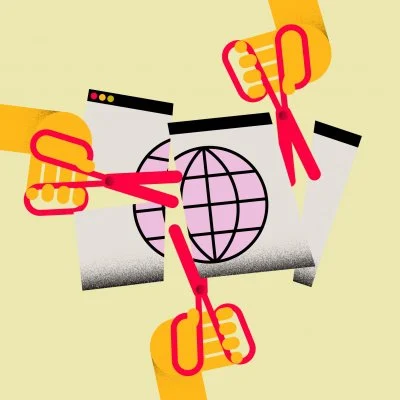There are networks that your network is connected with and has a relationship with. Relationships between networks can take various forms, and different networks connect to varying numbers of neighbouring networks in different ways.
One way is to use a third-party network, a transit provider, to give your network access to the Internet. It is possible to have a contractual “transit” relationship. In this case, you need a transit agreement with a network which will be responsible for transporting data from your network to the rest of the Internet. This intermediate network transports the traffic for you either directly to the destination network or via their own transit partners. Such a transit relationship costs money, because the transit provider needs to make sure its network is big enough to route not only your traffic through it, but also that of all their other transit customers.
However, if your network is only connected to a single transit network, then you are highly vulnerable to communication breakdowns. This happens typically with small ISPs or small hosters – they often buy transit from only one provider, simply because of the cost of transit. The problem is, if there is a disruption with this transit provider’s network, then your network is no longer available on the Internet.
Another way of connecting to other networks is what is known as “peering”, which is exchanging data traffic on a cost-neutral basis via an Internet Exchange (IX). By putting an Internet Exchange in the middle, you don’t have to manage relations to other networks individually, or pay them to take your data traffic. It’s best to connect to an IX which is geographically close to your network location.
As an example for Kuala Lumpur, if you were to peer at an exchange like DE-CIX Kuala Lumpur, you would be able to reach more than 60 other networks directly. In this case, you only need to pay for your access to the exchange, and then you can connect to as many of these networks as you deem necessary. You can also establish several such transfer points – not simply one connection in Kuala Lumpur, but perhaps two connections from different data centres, and maybe also one in Johor Bahru or Singapore. Then, if there is a disruption somewhere, the other networks you are connected to can make sure that communication continues. We, technicians, call this use of multiple connections “redundancy”, and we prepare ourselves precisely for the fact that a link can break, a connection can go down, a bulldozer digging up the street can cut a cable accidentally. We want the flow of data traffic to continue undisturbed in such a situation. With such redundancy, the flow does continue, and then no one notices the outage.
Can the Internet go down?
Locally, within a network, it is possible for disruption to mean that you can’t access services. We’ve all had days where websites load slowly or nothing happens at all. But this is generally a local issue involving one ISP or one transit provider, or perhaps a local data centre. However, it’s basically not possible to disconnect a whole country from the Internet, at least not from the outside, and certainly not easily. Of course, there are increasingly frequent examples resulting from natural
catastrophes.
We recently saw a volcanic eruption in Tonga. There were just two submarine cables connecting Tonga to the outside world, and both were destroyed. As a result, the whole island was then disconnected from the Internet. This kind of catastrophe is now the exception rather than the rule because large countries typically have many independent links to the Internet.
Internet service
providers that offer Internet to companies or private individuals, for example, have a large number of connections to other networks in other countries.
In late December, local users experienced a lag in their Internet connections due to a faulty submarine cable. While news reports did not mention which cable it was exactly, a notice from a local telecommunications provider mentioned that the fault happened somewhere in North Asia.
Taking into account that the distance from Malaysia to the northern parts of Asia is more than 5,000 kilometres, it’s interesting to note that even a mishap that far away can affect local end users.
So, can the Internet go down? Indeed, it can – from inside the country. If a country decides for itself that it’s not going to allow any more connections to the outside world, the government can initiate a law prohibiting it, then a country can splinter itself off – cut all outside connections and disconnect itself from the Internet. There are several ways of doing this.
One mechanism would be to enforce the filtering of certain IP addresses, so that Internet service providers within the country are prohibited from passing on data packets unless they come from devices within the country that are authorised to access the Internet. A further possibility is to force the ISPs to remove private customers from the BGP routing (an example of this is North Korea). In this way, authorised devices would still have full access to the Internet, while citizens and other non-government actors would be completely isolated from it. Another recent example of the Splinternet is Myanmar, where the country’s Internet has been severely curtailed, with the ruling military council increasing tax on Internet access and imposing cost barriers to prevent ordinary citizens from accessing even those Internet services that have not been blocked outright – a less technical, but nonetheless effective mechanism.
If a country disconnects itself from the Internet, this impacts neighbouring countries in various ways. If the content is hosted in a country which is now separated from the Internet, Internet users from outside the country will no longer be able to access this content. Furthermore, Internet traffic being transported internationally typically flows through multiple countries to get to its destination. In the case that a country disconnects itself from the Internet, traffic would need to detour around that country. Users in neighbouring countries would perceive this detour as a deterioration of the quality of the Internet connection, such as increased latency times and less bandwidth available.
How does the Splinternet affect Malaysians?
Malaysia, fortunately, is highly interconnected with neighbouring countries via a wealth of undersea cables. This offers networks multiple international routes to enable their traffic to flow and therefore improves the resilience of connectivity into the country. Therefore, unlike Tonga, Malaysian Internet connectivity is, as a whole, well fortified against natural disasters and incidents within the region. As a result, even if a neighbouring country were to splinter itself off from the global Internet, the flow-on effect would downgrade the performance and end-user experience of the Internet in Malaysia would be minimal.
Why neutrality is important for infrastructure providers
We believe that infrastructure should be available to all. Information should be allowed to flow freely to enable education, access to information, and economic development, everywhere. Of course, network operators and digital infrastructure of all kinds need to be subject to their local jurisdictions and lawmakers, but it is also important to understand that good connectivity has an impact on a wider regional scale – so, working together to ensure that data can flow and business
opportunities can arise creates a win/win situation for an entire region like Southeast Asia. A splintering of the Internet into isolated countries will have a negative impact on the performance and the reliability of Internet connectivity, everywhere, and would, in the long run, destroy the concept of the Internet – an open and technology-neutral reservoir of information, and a tool for interacting with the world.
Article contribution: Dr. Thomas King, CTO, DE-CIX









